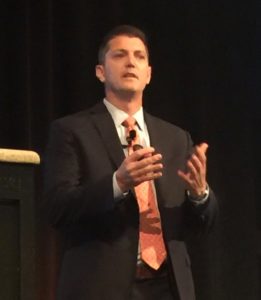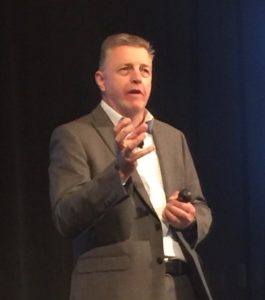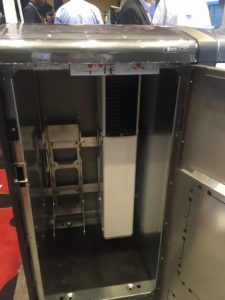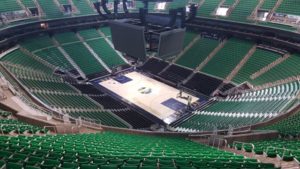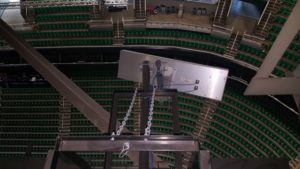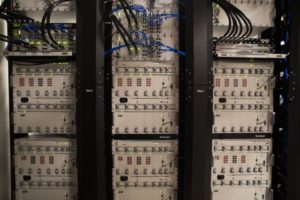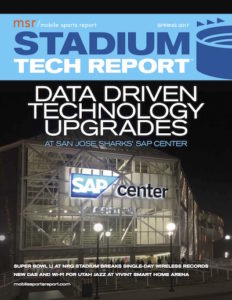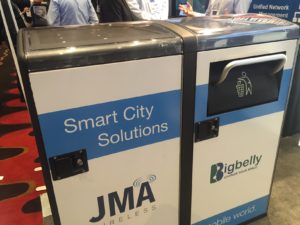
JMA Wireless shows ‘smart’ trash bins at DAS and Small Cells Congress in Las Vegas. Credit all photos: Paul Kapustka, MSR
And while the end product of the market transformation is still uncertain, executives from DAS gear manufacturers, cellular carriers and other industry experts all agreed on one thing: In the near future, the DAS industry won’t look at all like it does today.
For large public venue owners specificially, the days of carrier-funded DAS deployments may already be at an end, unless your stadium is in line to host a Super Bowl. Tightening budgets due to economic pressures on the nation’s biggest cellular carriers means that the recent years of free spending by AT&T and Verizon Wireless may have already gone by, putting more pressure on venue owners to find different financial models to bring cellular signals inside their buildings.
“There was never a problem I couldn’t throw more money at,” said Philip French, executive director for the West and North Central areas for Verizon, during a Tuesday keynote session at the Planet Hollywood hotel. “Those days are gone.”Also putting pressure on traditional DAS designs are the emergence of small cells, basically smaller versions of carrier macro towers that, like DAS, are used primarily to bring connectivity inside buildings or to urban areas with RF challenges, like crowded city streets. Experiments with newer “5G” cellular technologies and trials of networks at newer slices of spectrum, like the Citizens Broadband Radio Service (CBRS) at 3.5 GHz, may also impact the traditional DAS architectures as carriers and building owners look for ways to get more connectivity bang for the buck.
Getting more worth out of the network
Seth Buechley, chairman and CEO of business-advisory firm Cathedral Consulting (and former co-founder of DAS equipment provider SOLiD USA), said that the biggest cellular carriers are under increasing pressure to improve their bottom lines, a situation that could affect the DAS industry by drying up the funds previously used to bring DAS deployments to places like stadiums and arenas. AT&T, for example, has already disbanded the internal group that led an industry charge to bring DAS to many sports venues at no charge to teams or facility owners.
“Internal [carrier] competition for resources is the biggest threat to DAS,” Buechley said.
In his remarks, Verizon’s French noted that the “unlimited” data plans that have resurfaced for major carriers like Verizon are putting “a tremendous amount of pressure” on budgets. Another current popular DAS business model, where a third-party operator builds a stadium network and then signs up carriers on a subscription model, may also be in danger as carriers hold off on participating. At Texas A&M, T-Mobile recently signed a $3.5 million deal to get its signals on the DAS network at 102,512-seat Kyle Field, where AT&T and Verizon both paid in the neighborhood of $5 million for their access to the network.
Unless your facility is that big or it’s getting ready to host a big event like WrestleMania or the Super Bowl, where DAS traffic is likely to be off the charts, the carriers may not be as ready to pay.“We still love the NFL, but neutral host [participation] can be very expensive for Verizon,” French said.
More network intelligence = more revenue opportunity
Todd Landry, corporate vice president for product and market strategy at DAS supplier JMA Wireless, said the DAS industry needs to look at its own offerings to see how it can help its customers get more out of their networks.
“We’ve got to re-imagine what we’re trying to do,” said Landry. “What do we do with the network to get more out of it?”
Specifically, Landry sees advancements in DAS network intelligence as a prime opportunity to provide more value rather than simply cutting costs. At the conference, JMA was showing a prototype of a “DAS trash can,” a hardened waste bin (with solar power) that could also host a DAS antenna inside. Another attached bin was shown with a connected sensor that could tell operators whether the can was full or not, eliminating the need for multiple truck rolls just to check on whether the bin needed to be emptied.
For stadiums and other public spaces like shopping malls, Landry said parking spots might have sensors that could indicate whether or not a spot was available — and then relay that information to a self-driving car, which could drop off its passengers at the venue, then proceed on to park itself. Such a service could be offered for a fee to game or mall attendees.“As we go forward, we need be more clever,” Landry said. “We need to take more knowledge [from] the plumbing, and extract value from it.”
And even while technologies like “5G” and CBRS, which uses LTE technology to provide what proponents see as a sort of “private cellular” environment, may be a few years off from practical deployments, Landry said their presence is already being felt and absorbed by firms building current-day DAS gear. Elements of small cells and DAS, he said, “will come together,” as the equipment vendors “re-imagine what we’re doing for the industry.”
While there may be multiple paths forward for the DAS market, all in attendance seemed to agree with Landry’s final statement: “Things will be very different from what you know today.”
